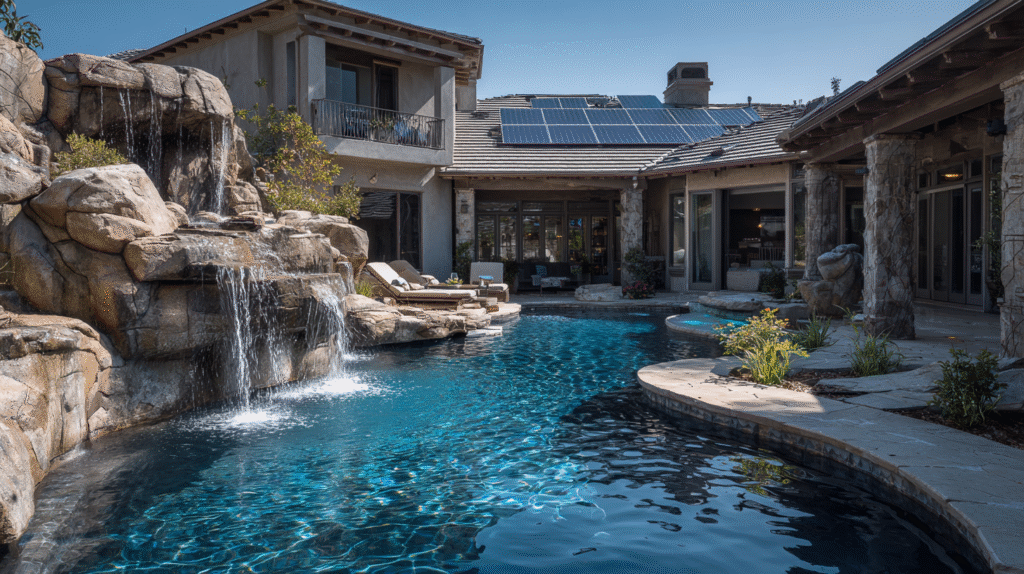Swimming pools provide an excellent place for relaxation and fun but can use up a lot of energy and water. Knowing where this energy is used is essential to making smarter choices. The pool pump, heating system, and lighting are the main contributors to your pool’s energy consumption. By assessing how each element impacts your overall energy usage, you can recognize opportunities for improvement. For instance, pool pumps are often the most significant energy drain, as they must run frequently to keep the water clean and circulated. Heating systems, especially in cooler climates, also generate high energy bills. Finally, lighting, while essential for safety and ambiance, can be optimized with energy-efficient options. By focusing on these key areas, you can develop a plan to reduce your pool’s energy footprint and save money in the long run.
Optimizing pool pump operations
Optimizing your pool pump’s operation is crucial for energy efficiency. A variable-speed pool pump is a game-changer in this regard. Unlike single-speed pumps, variable-speed pumps let you adjust the flow rate to match the pool’s needs, conserving energy during low demand.
To get the most out of your variable-speed pool pump, program it to run at lower speeds for extended periods, ensuring efficient water circulation and filtration. This approach uses significantly less power compared to high-speed operation. You can set the pump to higher speeds when necessary, like during cleaning or when using water features.
Regularly adjust the pump settings based on seasonal changes and pool usage to maintain peak efficiency. Using a variable-speed pump reduces energy consumption and extends the pump’s lifespan, resulting in long-term savings. By fine-tuning your pump’s operation, you can achieve a cleaner, more energy-efficient pool without compromising performance.
Reducing water loss
Evaporation is a primary factor in pool water loss, especially in hot and dry climates. To combat this, consider installing windbreaks or strategically using landscaping to protect the pool from wind exposure. Additionally, using a solar cover can significantly reduce evaporation while retaining heat, making it a dual-purpose tool for water and energy conservation.
Regular pool maintenance is essential to detect and fix leaks promptly. Signs of potential leaks include wet areas around the pool or an unexplained drop in water levels. Addressing these issues quickly will help prevent substantial water loss and keep the structural integrity of your pool.
Maintaining proper water levels also helps ensure the efficient operation of your pool’s equipment. Overfilling or underfilling can strain the pump and filtration systems, leading to increased energy consumption and potential damage. By closely monitoring your pool’s water level and performing regular inspections, you can minimize water loss and optimize your pool’s overall efficiency.
Using technology to monitor efficiency
Innovative pool management systems offer a range of features designed to optimize efficiency. These systems allow you to remotely monitor and control your pool’s functions, such as the pump, heater, and lighting. With real-time data at your fingertips, you can make informed decisions about adjustments that could lead to energy and water savings. For example, you can analyze the data to fine-tune your variable speed pool pump settings or adjust heating schedules based on actual usage patterns. Many smart systems also provide alerts for maintenance needs, helping you address issues before they become costly problems. By utilizing technology to track and manage your pool’s operations, you can ensure that your pool is running as efficiently as possible, making it easier to maintain an eco-friendly and cost-effective setup.
Eco-friendly pool cover options
Opting for an eco-friendly pool cover can significantly impact water and energy conservation. Solar pool covers are a popular choice as they minimize evaporation and harness solar energy to naturally heat the pool water. This can substantially lower the need for additional heating, reducing energy costs. Thermal pool covers provide excellent insulation, maintaining the pool’s temperature and reducing heating requirements. Automatic covers offer convenience and efficiency, allowing you to cover and uncover your pool with the push of a button, ensuring the cover is used consistently.
Using a pool cover also helps keep debris out of the pool, so your filtration system doesn’t have to work as hard. This reduces the energy needed for cleaning and chemical treatments, enhancing overall efficiency. Pool covers can be tailored to fit various pool shapes and sizes, ensuring a snug fit that maximizes their effectiveness. Investing in a high-quality, eco-friendly pool cover is a smart way to protect your pool, save resources, and reduce maintenance efforts.
By adopting these strategies, you improve your pool’s environmental footprint and enjoy financial benefits through reduced energy and water bills. It’s a proactive approach that pays off in the short and long term, making your pool a model of efficiency and sustainability. Embracing these changes creates a more enjoyable and responsible pool experience, benefiting you and the planet.






